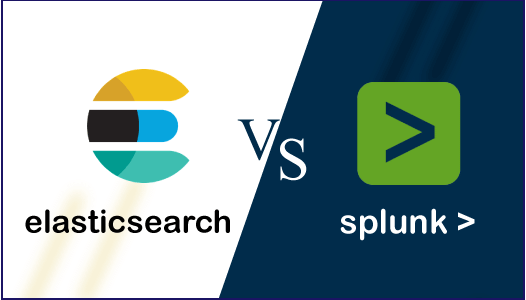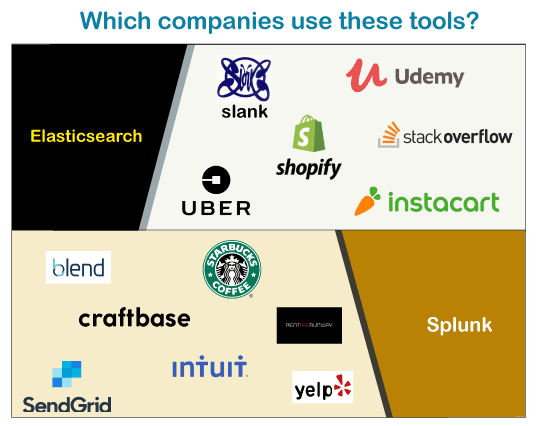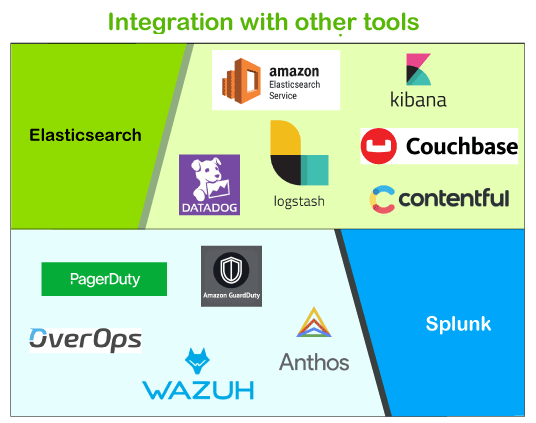Elasticsearch vs SplunkBoth ElasticStack (ELK Stack) and Splunk are biggest enterprise solutions for log analytics. Elasticsearch is a database search engine, and Splunk is a software tool for monitoring, analyzing, and visualizing the data. Elasticsearch stores the data and analyzes them, whereas Splunk is used to search, monitor, and analyze the machine data. One of the biggest disadvantage of Splunk till now is it is a paid and expensive tool whereas Elasticsearch is a free tool. 
However, Elasticsearch and Splunk have some similarities but also different from each other as well. They have some differences which make them different from each other. First, we will discuss briefly about Elasticsearch and Splunk separately and then differences. Below is a list of differences of Elasticsearch and Splunk. ElasticsearchElasticsearch is an open-source database tool that can be easily deployed and operated. It is used for the analytic purpose and searching your logs and data in general. Basically, it is a NoSQL database to store the unstructured data in the document format. Remember that Elasticsearch can perform all three analysis, visualization and search operations on data only by integrating with Logstash and Kibana tools. The integration of Elasticsearch with Logstash and Kibana is known as ELK stack. SplunkSplunk is a software platform or a tool that is used to search, visualize, monitor, and analyze the machine data. The data is generated by the machine in real-time. It comes from websites, devices, sensors, web applications, or it can be created by the user. Splunk is a tool that offers commercial solutions for 15 days free trial. It was released in 2003 which is a paid tool. Splunk can analyze structured or semi-structured data. It is mainly used for big data analysis. Splunk is equal to ELK Stack that has Elasticsearch, Logstash, and Kibana for storage, analysis, and visualization. Difference between Elasticsearch and SplunkElasticsearch and Splunk both help analyze the data. Based on some parameters, we will discuss their differences in detail. A list of differences is given below: Elasticsearch vs Splunk - CustomersSeveral companies like Uber, Stack Overflow, Udemy, Shopify, Instacart, and Slank, etc. use ElasticStack to store, analyze, search, and visualize their data. Where Elasticsearch, Logstash, and Kibana perform their role very sharply. 
On the other hand, Splunk is also used by a number of companies like Starbucks, Craftbase, Intuit, SendGrid, Yelp, Rent the Runway, and Blend, etc. Elasticsearch vs Splunk - Integration withElasticsearch tool integrates with Logstash and Kibana to work the same as Splunk. Apart from that, it can also integrate with various other tools, such as - Datadog, Couchbase, Amazon Elasticsearch Services, and Contentful, etc. By integrating with Logstash and Kibana, it works like Splunk. 
Splunk can also integrate with several other tools like OverOps, Google Anthos, PagerDuty, Amazon Guard Duty, and Wazuh, etc. Elasticsearch vs Splunk - CostElasticsearch is an open-source tool, which means it is freely available. The users can start using it without paying any cost by just downloading and installing it on their system. You can install it from its official website. For the installation step, go through with our Elasticsearch installation chapter (https://www.javatpoint.com/download-and-install-elasticsearch#Download). Note that you have to pay $45/month for Kibana (data visualization tool). Now, if we talk about Splunk, it is not an open-source tool. So, it is not freely available in the market. You have to pay for it in dollars to use. Splunk comes with 15 days free trial. Splunk cost is lightly starts at $75 per month. On the other hand, the enterprise starting of Splunk is $1800/year for 1GB data per day indexing. The cost of using Splunk is increased data indexed per day. Elasticsearch vs Splunk - ReleaseElasticsearch was released in 2010 by Shay Banon. It came when people wanted some other tool to compare the Splunk's performance. Splunk was released in 2003 by Michael Baum, Erik Swan, and Rob Das. They came up with the solution of capturing data logo and machine data logs to confirm the system's integrity. Data Migration and User ManagementBasically, it depends on the type of data formats supported by these tools. Elasticsearch and Splunk both are having data shipper objects which maintain the path of the files and uploads. Elasticsearch has no pre-loaded wizards and features. Even it does not have interactive UI so that the users need to install a plugin or Kibana with it. In Elasticsearch, we have to define the mapping of each field type to its value. Splunk comes with pre-loaded wizards and features which are easy and reliable for use. These features help the manager to manage the resources. Along with that, it also has inbuilt and pre-configured features that enable the user to map the data into entities with their respective values. Conclusion: If we come to a conclusion, Splunk is an easy and reliable approach in case of data migration and user management, whereas Elasticsearch is getting these features very fast. UI and Dashboard VisualizationMost of the time, users want to work with a graphical user interface which is easy to use and understand. They get familiar with it in very less time. Splunk improved its UI with a new dashboard and its controls. It has cool features of exporting their dashboard to PDF. On the other side, Elasticsearch does not has its own UI (User Interface). The user needs to install Kibana to perform the task. Kibana has cool background themes that Splunk doesn't have. Its dashboard contains different controls to take action. Therefore, the dashboard in Kibana is kind of better than Splunk.
Next TopicElasticsearch vs Cassandra
|
 For Videos Join Our Youtube Channel: Join Now
For Videos Join Our Youtube Channel: Join Now
Feedback
- Send your Feedback to [email protected]
Help Others, Please Share










